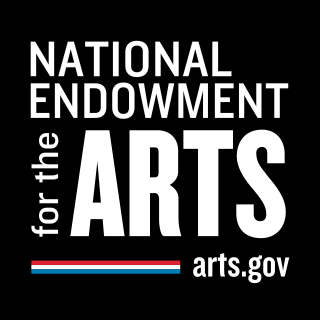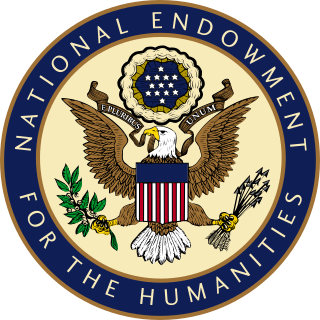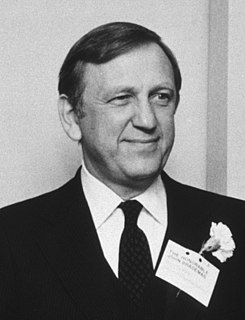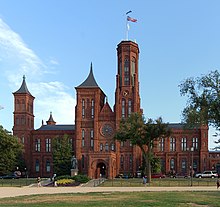
The National Endowment for the Arts (NEA) is an independent agency of the United States federal government that offers support and funding for projects exhibiting artistic excellence. It was created in 1965 as an independent agency of the federal government by an act of the U.S. Congress, signed by President Lyndon B. Johnson on September 29, 1965. The foundation consists of the National Endowment for the Arts, the National Endowment for the Humanities, the Federal Council on the Arts and the Humanities, and the Institute of Museum and Library Services.
The "NEA Four", Karen Finley, Tim Miller, John Fleck, and Holly Hughes, were performance artists whose proposed grants from the United States government's National Endowment for the Arts (NEA) were vetoed by John Frohnmayer in June 1990. Grants were overtly vetoed on the basis of subject matter after the artists had successfully passed through a peer review process. John Fleck was vetoed for a performance comedy with a toilet prop. The artists won their case in court in 1993 and were awarded amounts equal to the grant money in question, though the case would make its way to the United States Supreme Court in National Endowment for the Arts v. Finley. In response, the NEA, under pressure from Congress, stopped funding individual artists.

The National Endowment for the Humanities (NEH) is an independent federal agency of the U.S. government, established by the National Foundation on the Arts and the Humanities Act of 1965, dedicated to supporting research, education, preservation, and public programs in the humanities. The NEH is housed at 400 7th St SW, Washington, D.C. From 1979 to 2014, NEH was at 1100 Pennsylvania Avenue, N.W., Washington, D.C. in the Nancy Hanks Center at the Old Post Office.

The National Medal of Arts is an award and title created by the United States Congress in 1984, for the purpose of honoring artists and patrons of the arts. A prestigious American honor, it is the highest honor given to artists and arts patrons by the United States government. Nominations are submitted to the National Council on the Arts, the advisory committee of the National Endowment for the Arts (NEA), who then submits its recommendations to the White House for the President of the United States to award. The medal was designed for the NEA by sculptor Robert Graham.

The Andrew W. Mellon Foundation of New York City in the United States, simply known as Mellon Foundation, is a private foundation with five core areas of interest, and endowed with wealth accumulated by Andrew Mellon of the Mellon family of Pittsburgh, Pennsylvania. It is the product of the 1969 merger of the Avalon Foundation and the Old Dominion Foundation. These foundations had been set up separately by Ailsa Mellon Bruce and Paul Mellon, the children of Andrew Mellon.
The President's Committee on the Arts and the Humanities (PCAH) was an advisory committee to the White House on cultural issues. It worked directly with the Administration and the three primary cultural agencies: the National Endowment for the Arts, National Endowment for the Humanities, and the Institute of Museum and Library Services, as well as other federal partners and the private sector, to address policy questions in the arts and humanities, to initiate and support public/private partnerships in those disciplines, and to recognize excellence in the field. Its core areas of focus were arts and humanities education, cultural exchange, and the creative economy.

Stephen John Brademas Jr. was an American politician and educator originally from Indiana. He served as Majority Whip of the United States House of Representatives for the Democratic Party from 1977 to 1981 at the conclusion of a twenty-year career as a member of the United States House of Representatives. In addition to his major legislative accomplishments, including much federal legislation pertaining to schools, arts, and the humanities, he served as the 13th president of New York University from 1981 to 1992, and was a member of and subsequently the chairman of the board of the Federal Reserve Bank of New York. In addition he was a board member of the New York Stock Exchange and the Rockefeller Foundation.

Nancy Hanks (1927–1983) was the second chairman of the National Endowment for the Arts (NEA). She was appointed by President Richard M. Nixon and served from 1969 to 1977, continuing her service under President Gerald R. Ford. During this period, Hanks was active in the fight to save the historic Old Post Office building in Washington, D.C. from demolition. In 1983, it was officially renamed the Nancy Hanks Center, in her honor.

Cultural policy is the government actions, laws and programs that regulate, protect, encourage and financially support activities related to the arts and creative sectors, such as painting, sculpture, music, dance, literature, and filmmaking, among others and culture, which may involve activities related to language, heritage and diversity. The idea of cultural policy was developed at UNESCO in the 1960s. Generally, this involves governments setting in place processes, legal classifications, regulations, legislation and institutions which promote and facilitate cultural diversity and creative expressions in a range of art forms and creative activities. Cultural policies vary from one country to another, but generally they aim to improve the accessibility of arts and creative activities to citizens and promote the artistic, musical, ethnic, sociolinguistic, literary and other expressions of all people in a country. In some countries, especially since the 1970s, there is an emphasis on supporting the culture of Indigenous peoples and marginalized communities and ensuring that cultural industries are representative of a country's diverse cultural heritage and ethnic and linguistic demographics.

The Institute of Museum and Library Services (IMLS) is an independent agency of the United States federal government established in 1996. It is the main source of federal support for libraries and museums within the United States, having the mission to "create strong libraries and museums that connect people with information and ideas." In fiscal year 2015, IMLS had a budget of $228 million.
Arts administration is a field in the arts sector that facilitates programming within cultural organizations. Arts administrators are responsible for facilitating the day-to-day operations of the organization as well as the long term goals by and fulfilling its vision, mission and mandate. Arts management became present in the arts and culture sector in the 1960s. Organizations include professional non-profit entities. For examples theaters, museums, symphonies, jazz organizations, opera houses, ballet companies and many smaller professional and non-professional for-profit arts-related organizations. The duties of an arts administrator can include staff management, marketing, budget management, public relations, fundraising, program development evaluation, and board relations.
Arts Midwest, headquartered in Minneapolis, Minnesota, is one of six not-for-profit regional arts organizations created to “encourage development of the arts and to support arts programs on a regional basis.” Arts Midwest's mission is to "promote creativity, nurture cultural leadership, and engage people in meaningful arts experiences, bringing vitality to Midwest communities and enriching people’s lives.” Arts Midwest is primarily funded by the National Endowment for the Arts (NEA), and is charged with supporting artists and arts organizations, and providing assistance to its nine member states of Illinois, Indiana, Iowa, Michigan, Minnesota, North Dakota, Ohio, South Dakota, and Wisconsin.

Robert Sidney Martin, Ph.D. is an American librarian, archivist, administrator, and educator. He is Professor Emeritus, School of Library and Information Studies, Texas Woman’s University, where he was the Lillian M. Bradshaw Endowed Chair until his retirement in 2008.
Bill O'Brien is a television series actor, and the Senior Advisor for Program Innovation for the National Endowment of the Arts.

Preserve America is a United States government program, established under President George W. Bush, intended to encourage and support community efforts to preserve and enjoy the country's cultural and natural heritage.
Songs of Hope is an international performing arts summer camp in Minnesota, United States, founded in 1990 by the Minnesota nonprofit organization, Sounds of Hope Ltd. The camp hosts children aged 10-13 from the United States and abroad, who participate in a program built around cultural sharing. The country delegations are partly subsidized by corporate and foundation donors. The project also has a focus on performance, and the children go on a three-week concert tour at the end of the six-week program each summer.
Manitoba Sport, Culture and Heritage is the department of the Government of Manitoba responsible for managing government programs and services that support the sport, art, culture, and heritage of the province, through developing, supporting, promoting, and celebrating the identity and well-being of Manitoba and its communities.
National Endowment for the Arts v. Finley, 524 U.S. 569 (1998), was a United States Supreme Court case in which the Court ruled that the National Foundation on the Arts and Humanities Act, as amended in 1990,, was facially valid, as it neither inherently interfered with First Amendment rights nor violated constitutional vagueness principles. The act in question required the Chairperson of the National Endowment for the Arts (NEA) to ensure that "artistic excellence and artistic merit are the criteria by which [grant] applications are judged, taking into consideration general standards of decency and respect for the diverse beliefs and values of the American public". Justice O'Connor delivered the opinion of the Court.

The D.C. Commission on the Arts and Humanities (CAH) is an agency of the District of Columbia government. CAH was created as an outgrowth of the U.S. Congress act that created the National Foundation on the Arts and Humanities. In 1965 the foundation provided for two operating federal agencies: the National Endowment for the Arts and the National Endowment for the Humanities. As of October 2019, the Interim Director is Heran Sereke-Brhan CAH has its office is located in the Navy Yard neighborhood of southeast Washington, D.C. The chairperson of the D.C.Commission on the Arts and Humanities is Reggie Van Lee and the vice chairperson is Maggie FitzPatrick. The current commissioners appointed by Mayor Muriel Bowser and confirmed by the DC Council are: Stacie Lee Banks, Cora Masters Barry, Maggie FitzPatrick, Quanice Floyd, Rhona Wolfe Friedman, Natalie Hopkinson, Kymber Menkiti, Maryann Miller, Maria Hall Rooney, Cicie Sattarnilasskorn, Carla Sims, Hector Torres, Jose Alberto Ucles, Gretchen Wharton, Derek Younger.

The Athens-Clarke County Library is the headquarters and main branch of the Athens Regional Library System. It is located in Athens-Clarke County, Georgia. The structure contains two stories that are open to the public. It contains a YA Department, Children's Department, and Heritage Room, which maintains a local archival collection about Clarke and surrounding counties.












